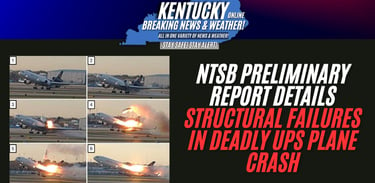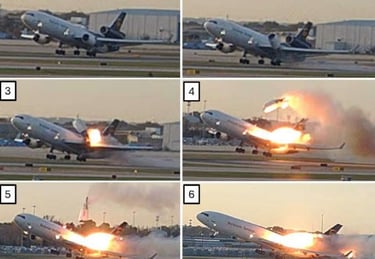Kentucky News
NTSB Preliminary Report Details Structural Failures in Deadly UPS Plane Crash
NEWS
11/17/2025
The NTSB also confirmed which of the three pilots on board was at the controls during takeoff. First Officer Lee Truitt, of Albuquerque, New Mexico, was flying the aircraft at the time of the catastrophic failure.
While the newly released photos and structural findings provide valuable insight into what occurred, the NTSB stresses that the investigation is still ongoing. The preliminary report does not identify the cause of the crash. A final report — including an analysis of contributing factors and potential safety recommendations — could take up to a year to complete.
The cargo plane, an MD-11, crashed on November 4 shortly after departing Louisville Muhammad Ali International Airport. In the days following the tragedy, UPS and the Federal Aviation Administration temporarily grounded all MD-11 aircraft as a precaution while investigators reviewed the fleet for similar structural concerns.
More updates are expected as the NTSB continues its detailed examination of the aircraft, its components, and flight data.
IMAGES LISTED BELOW
This report was compiled using information gathered from law enforcement statements, official press releases, and publicly available news sources.
Advertisements on this page appear at random and are not selected by this website.




NTSB Preliminary Report Details Structural Failures in Deadly UPS Plane Crash
(IMAGE LARGER AT THE END OF STORY)
LOUISVILLE, Ky. — The National Transportation Safety Board has released its preliminary findings into the tragic UPS cargo plane crash that killed 14 people and injured several others earlier this month. The early report includes newly released photographs, diagrams, and technical observations that shed more light on what happened in the moments leading up to the aircraft’s deadly descent.
Among the new information are never-before-seen photos showing the plane’s left engine and its pylon — the structure that connects the engine to the wing — breaking away shortly after takeoff. The sequence of images captures the beginning of the separation, the moment the components tore free, and the instant they ignited into flames. Investigators highlighted photos 2, 3, and 4 as key evidence demonstrating the rapid progression of the failure.
According to the NTSB, the left pylon showed fatigue cracks, which are slow-growing fractures caused by repeated stress over time. These cracks were found in the aft mount lugs, along with a fractured aft spherical bearing race. The report also notes that sections of the pylon exhibited “overstress failure,” indicating the structure was pushed far beyond its physical limits at the time it failed.
The report states that the pylon components underwent a detailed visual inspection in 2021 and were not yet due for their next scheduled inspection at the time of the crash. Investigators are now examining whether any signs of damage could have been detected earlier, or whether the failure developed unexpectedly between inspection intervals.
Follow on Facebook:
© 2025 All rights reserved.
All content shared on this website is compiled from publicly available information, including official law enforcement statements, press releases, and verified news sources. We are not an official news organization and do not independently investigate incidents. While every effort is made to ensure accuracy, information may be updated or corrected as new details become available. This website and its administrators are not responsible for any errors, omissions, or actions taken based on the information provided.
